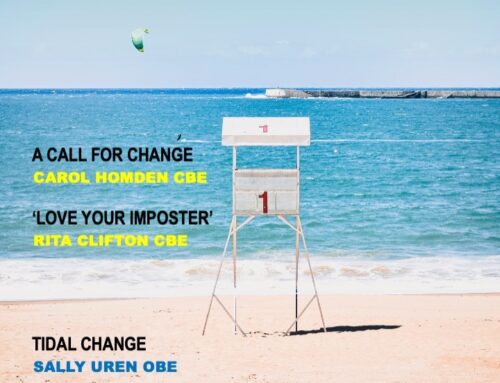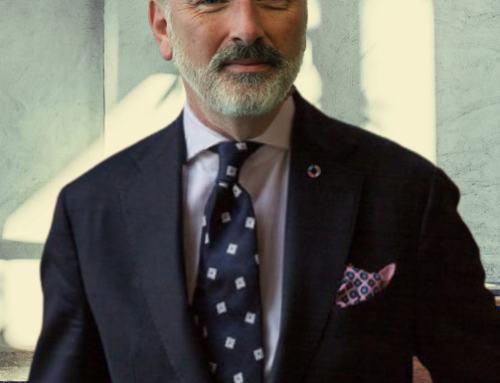A Collective Kindness
Maggie’s centres today and tomorrow
When artist and designer Maggie Keswick Jencks recognised the vital need for a new kind of support for those with cancer, she couldn’t have known the scale of the Maggie’s charity 25 years later. It is a story of exceptional generosity, determination and kindness.
Maggie Keswick Jencks was undergoing treatment for cancer herself and while receiving excellent clinical care a key area of support was missing – independent advice and moral support. Sadly, she died in 1995 but with the creative input of her husband, the writer and architectural critic Charles Jencks, and support from her family the first centre opened in 1996. Designed by award-winning architect Richard Murphy out of an old stable block at the Western General Hospital in Edinburgh, it blends traditional Scottish stonework with contemporary architectural thinking.

Visitors at a Maggie’s Centre
In early 2021 a new centre will open in Southampton, designed by Amanda Levete (in a garden evoking the nearby New Forest) with a collaboration involving ceramist and writer Edmund de Waal. There are now 23 such centres across the UK and three internationally, designed by a range of outstanding architects, several of which, such as Maggie’s West London by Richard Rogers, have become architectural icons. But however crucial the architecture in making places of tranquillity, the principal focus is on the needs of those with cancer and their families.

Maggie’s West London by Rogers Stirk Harbour + Partners, 2008
Over the quarter century it is Maggie’s CEO, Dame Laura Lee, originally a cancer nurse caring for Maggie, who has guided the extraordinary growth of the organisation, supported entirely by many voluntary donations and contributions in kind from architects and artists. As she puts it:
The diagnosis of cancer, Maggie felt is a bit like being flung out of a plane with a parachute that may or may not open, and no map when you land behind enemy lines. You needed … someone to help put together your map which takes into account your personal circumstances and your personal belief system.
Maggie didn’t want to lose the joy of living in the fear of dying; she wanted to live with optimism and hope.
Approaching the Maggie’s centre in Dundee you encounter a striking figure standing bold and to one side of the now famous 2003 building created by American architect Frank Gehry. The cast-iron sculpture is Another Time X (2009) by Antony Gormley, creator of Gateshead’s great Angel of the North. It was donated by Jay Jopling and is now very much part of the landscape designed by Arabella Lennox-Boyd.

‘Another Time X’ by Antony Gormley and Maggie’s Dundee by Frank Gehry
Maggie’s Dundee is typical of a Maggie’s centre in establishing much more than a functional building: fashioning a special place for patients, offering shelter and guidance at a tumultuous time. Also typical is the creative generosity of artists contributing alongside the architects and landscape designers to make Maggie’s such valued places. That generosity – a collective kindness – has now been extended through collaboration with private and public collections around the country, lending works of art over extended periods, including loans from the National Museum of Wales to Maggie’s Cardiff; Callum Innes paintings in Maggie’s Glasgow; works from The Whitworth and by Bridget Riley and Conrad Shawcross in Maggie’s Manchester; and collaboration with the Royal Academy at Maggie’s Royal Marsden. Works of art are thoughtfully matched to spaces – adding to the ambience, and occasionally offering helpful distraction.

Painting by Vanessa Jackson RA at Maggie’s Royal Marsden by Ab Rogers 2019
Some fifteen years ago a Maggie’s Art Group was established to advise on which artists and works might work best for the centres. As Chair of the Group, I respectfully suggest ideas to the architects while enticing artists and curators into new collaborations, and generally on a zero budget.
The Covid pandemic in 2020 has produced a terrible situation for those with cancer, some missing timely diagnosis, others their necessary treatments. The demand for the services of Maggie’s has greatly increased, even with the centres unable to receive visitors for many months. CEO Laura Lee clarified:
We will do everything we can at Maggie’s to give the best possible support to people with cancer whether it be in our centres, online or over the phone. We know this is a particularly difficult and worrying time and we are here for you.
At the same time most of Maggie’s everyday fund-raising was hugely reduced, being based on people in social groups. So the work of the Maggie’s Art Group has switched to helping raise funds. In collaboration with Christie’s an online auction was staged in July, involving notably generous donations by some 50 artists and architects and raising a much-needed £400,000. And now the artist Anish Kapoor has created the most beautiful signed print titled ‘Glow for Maggie’ – a polymer gravure type etching with the image debossed and with a border; image size 23 x 29 cm, on paper size 33 x 40 cm – and some copies from the edition are available. For Kapoor to donate these prints in support of Maggie’s is a very special kind of kindness, and as he put it, ‘Perhaps everyone who buys a print can feel as I do that we can help by working together.’

‘Glow for Maggie’ by Anish Kapoor, available to buy
The demand for the support that Maggie’s offer will continue to grow. If capital and revenue support is found then plans for new centres can progress. The architecture and design will be important but caring and kindness will be at their heart. Art will play its part, and as Antony Gormley puts it so plainly: ‘Art is the means by which we communicate what it feels like to be alive.’
Sandy Nairne CBE
Writer and curator,
Chair of the Maggie’s Art Group;
Trustee of the National Trust and Samuel Courtauld Collection.
Information about Maggie’s is at: https://www.maggies.org/
To acquire Anish Kapoor’s ‘Glow for Maggie’ 2020: Maggies.org/anishkapoor

A Collective Kindness
Maggie’s centres today and tomorrow
When artist and designer Maggie Keswick Jencks recognised the vital need for a new kind of support for those with cancer, she couldn’t have known the scale of the Maggie’s charity 25 years later. It is a story of exceptional generosity, determination and kindness.
Maggie Keswick Jencks was undergoing treatment for cancer herself and while receiving excellent clinical care a key area of support was missing – independent advice and moral support. Sadly, she died in 1995 but with the creative input of her husband, the writer and architectural critic Charles Jencks, and support from her family the first centre opened in 1996. Designed by award-winning architect Richard Murphy out of an old stable block at the Western General Hospital in Edinburgh, it blends traditional Scottish stonework with contemporary architectural thinking.

Visitors at a Maggie’s Centre
In early 2021 a new centre will open in Southampton, designed by Amanda Levete (in a garden evoking the nearby New Forest) with a collaboration involving ceramist and writer Edmund de Waal. There are now 23 such centres across the UK and three internationally, designed by a range of outstanding architects, several of which, such as Maggie’s West London by Richard Rogers, have become architectural icons. But however crucial the architecture in making places of tranquillity, the principal focus is on the needs of those with cancer and their families.

Maggie’s West London by Rogers Stirk Harbour + Partners, 2008
Over the quarter century it is Maggie’s CEO, Dame Laura Lee, originally a cancer nurse caring for Maggie, who has guided the extraordinary growth of the organisation, supported entirely by many voluntary donations and contributions in kind from architects and artists. As she puts it:
The diagnosis of cancer, Maggie felt is a bit like being flung out of a plane with a parachute that may or may not open, and no map when you land behind enemy lines. You needed … someone to help put together your map which takes into account your personal circumstances and your personal belief system.
Maggie didn’t want to lose the joy of living in the fear of dying; she wanted to live with optimism and hope.
Approaching the Maggie’s centre in Dundee you encounter a striking figure standing bold and to one side of the now famous 2003 building created by American architect Frank Gehry. The cast-iron sculpture is Another Time X (2009) by Antony Gormley, creator of Gateshead’s great Angel of the North. It was donated by Jay Jopling and is now very much part of the landscape designed by Arabella Lennox-Boyd.

‘Another Time X’ by Antony Gormley and Maggie’s Dundee by Frank Gehry
Maggie’s Dundee is typical of a Maggie’s centre in establishing much more than a functional building: fashioning a special place for patients, offering shelter and guidance at a tumultuous time. Also typical is the creative generosity of artists contributing alongside the architects and landscape designers to make Maggie’s such valued places. That generosity – a collective kindness – has now been extended through collaboration with private and public collections around the country, lending works of art over extended periods, including loans from the National Museum of Wales to Maggie’s Cardiff; Callum Innes paintings in Maggie’s Glasgow; works from The Whitworth and by Bridget Riley and Conrad Shawcross in Maggie’s Manchester; and collaboration with the Royal Academy at Maggie’s Royal Marsden. Works of art are thoughtfully matched to spaces – adding to the ambience, and occasionally offering helpful distraction.

Painting by Vanessa Jackson RA at Maggie’s Royal Marsden by Ab Rogers 2019
Some fifteen years ago a Maggie’s Art Group was established to advise on which artists and works might work best for the centres. As Chair of the Group, I respectfully suggest ideas to the architects while enticing artists and curators into new collaborations, and generally on a zero budget.
The Covid pandemic in 2020 has produced a terrible situation for those with cancer, some missing timely diagnosis, others their necessary treatments. The demand for the services of Maggie’s has greatly increased, even with the centres unable to receive visitors for many months. CEO Laura Lee clarified:
We will do everything we can at Maggie’s to give the best possible support to people with cancer whether it be in our centres, online or over the phone. We know this is a particularly difficult and worrying time and we are here for you.
At the same time most of Maggie’s everyday fund-raising was hugely reduced, being based on people in social groups. So the work of the Maggie’s Art Group has switched to helping raise funds. In collaboration with Christie’s an online auction was staged in July, involving notably generous donations by some 50 artists and architects and raising a much-needed £400,000. And now the artist Anish Kapoor has created the most beautiful signed print titled ‘Glow for Maggie’ – a polymer gravure type etching with the image debossed and with a border; image size 23 x 29 cm, on paper size 33 x 40 cm – and some copies from the edition are available. For Kapoor to donate these prints in support of Maggie’s is a very special kind of kindness, and as he put it, ‘Perhaps everyone who buys a print can feel as I do that we can help by working together.’

‘Glow for Maggie’ by Anish Kapoor, available to buy
The demand for the support that Maggie’s offer will continue to grow. If capital and revenue support is found then plans for new centres can progress. The architecture and design will be important but caring and kindness will be at their heart. Art will play its part, and as Antony Gormley puts it so plainly: ‘Art is the means by which we communicate what it feels like to be alive.’
Sandy Nairne CBE
Writer and curator,
Chair of the Maggie’s Art Group;
Trustee of the National Trust and Samuel Courtauld Collection.
Information about Maggie’s is at: https://www.maggies.org/
To acquire Anish Kapoor’s ‘Glow for Maggie’ 2020: Maggies.org/anishkapoor




